"This is the sort of cooking you always promise yourself you will do more of, because it turns making supper into a recreation rather than work." Nigel Slater
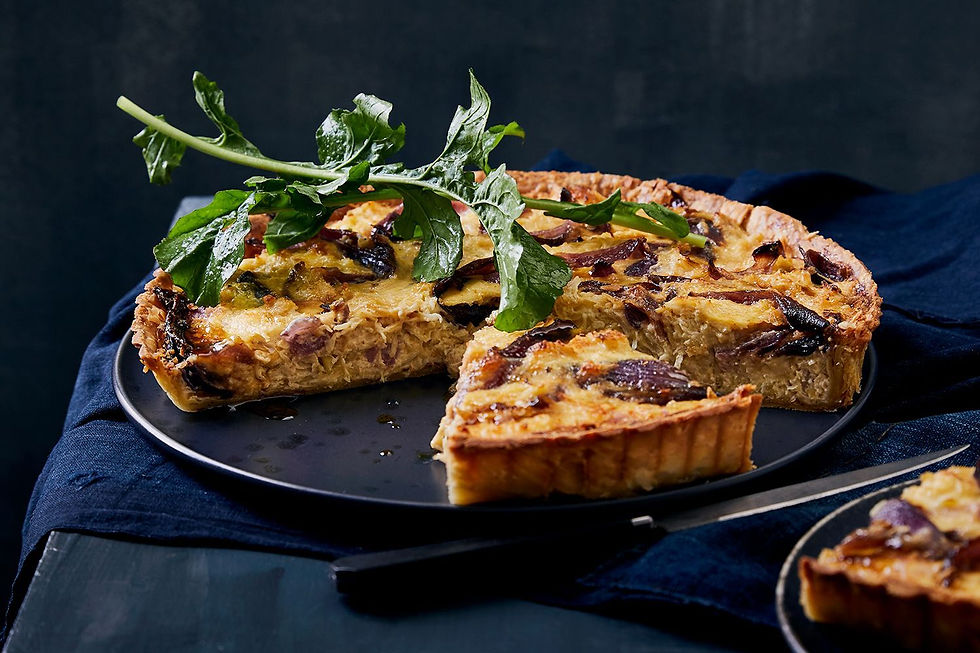
No I did not make the quiche above, and, in fact I have never made it although I think I might have a go - it's a delicious. recipe from Lucy Nunes for a Sauerkraut quiche with caramelised onions. Intriguing. Also a beautiful photograph which is why I chose it. I'll just scatter a few photographs from here and there as I go to make it a tiny bit interesting.
But I'm not here to write about quiche per se, or to give you recipes, because I've done that before, probably more than once. No I'm just talking about what I have learnt over the years, specifically about making a quiche, but also about various other cooking things along the way.
"Fridge cold quiche is clearly a crime." said Angela Clutton in The Guardian, which is sort of how I came to be writing this post, because my lunch was just that. The last slice of a quiche (mushrooms, leeks, mustard and ham) from a meal of a few days ago. Yes I ate it cold straight from the fridge, sprinkled with a little salt and pepper and it was delicious. Though admittedly it might have been better if I had taken it out of the fridge earlier in the day so that it was at least room temperature. Or reheated it in the oven - but that's a waste of electricity. Lesson number one - the main thing I have learnt about reheating - never reheat in the microwave, it just goes disgustingly soggy, and if you get the timing wrong the pastry also goes sort of chewy which is even more disgusting.
I cannot now remember where I first came across quiche. Not in France I think. In recent years of travel in France I have almost always bought quiche from a patisserie for my lunch, but in those long ago French exchange and au pair days, I don't think I ever ate quiche. I suspect it's because it's not really a suitable dish for a crowd - a family of four kids (including me) plus adults, in one case. It's not even really enough for four if they are hungry.

So where did I learn to make quiche - Elizabeth David, Jane Grigson, Robert Carrier? Maybe a mix of all three. In my head I have the basic mix for the filling as coming from Jane Grigson, but I can't find where. I have also checked Elizabeth David and Robert Carrier, with similar lack of success. Why? Well my basic custard mix these days is three eggs and 300ml of cream - what the supermarket calls reduced cream. But I vaguely remember less cream plus some milk at one point in my quiche making career and I may have tried Elizabeth David's 3 eggs and one yolk, but I never really know what to do with the leftover white. This is hers in the photograph - not a lot of bacon and much smoother and creamier looking than my efforts. Maybe it was Mastering the Art of French Cooking - they do say 3 eggs, or 2 eggs and 2 yolks. Anyway lesson number two - three eggs and 300ml of cream. Of course, if I was to make a particular quiche - like the one at the top of the page, I would follow the recipe to the letter (4 eggs, 250g crème fraïche in that case).
Next lessons. The pastry. This is an evolutionary thing. I began with just a basic shortcrust pastry - half butter to flour, and I would have made it individually for each quiche. And I'm pretty sure I learnt that from my mother, reinforced at school. By hand. Somewhere along the way and I'm pretty sure that this was indeed Jane Grigson - the queen of tarts to my mind - I began adding some polenta to the mix, which is brilliant, because it seems to make the pastry crisper. Of late I have also taken to adding some lemon juice or grated zest. Other recipes out there add cheese, and/or herbs and also use wholemeal flour rather than white. I also vaguely remember one Jane Grigson recipe that included oats - for a tomato quiche - about which more later.
If the above is lesson three then number four is to make the pastry in a big batch using my electric mixer. 500g flour - well a little bit less - say 25 grams of polenta included in that - a couple of hefty shakes from the jar anyway. Then 250g butter, plus the lemon juice, and zest, and water. Done in less than a minute really. It makes a big batch which I then divide into five balls usually. I freeze four and use one. This is my only attempt at batch cooking. The danger of cooking things in batches for me is that the frozen bits get forgotten in the fridge. Not the pastry though, because quiche is a regular meal in our house. Almost, but not quite, once a week, and often on a Friday for some reason. Funny how habits form is it not?

Now I know that you are supposed to keep everything chilled when you make pastry for tarts. This was reinforced today when I read Deb Perelman talking about making Thomas Keller's deeper quiche which she calls Over the top mushroom quiche:
"Keep. Your. Dough. Cold. Cold butter is firm and holds a shape; warm butter is mushy and has no structure." Deb Perelman/Smitten Kitchen
I can imagine that this is indeed most important when you are making a deep quiche like this, and the Americans seem to think that Thomas Keller is the king when it comes to quiche, but I don't think I have ever made a deep one, and most recipes out there are the usual relatively shallow kind.
Keeping it cool however, is supposed to be a good thing, and indeed when you have rolled it out and lined your tart tin, you are supposed to chill it in the fridge so that it won't shrink from the sides. Well people, mine shrinks from the sides and that's OK. I have also only occasionally chilled it. Maybe it's better - but not convincingly so for me. Does that count as a lesson?
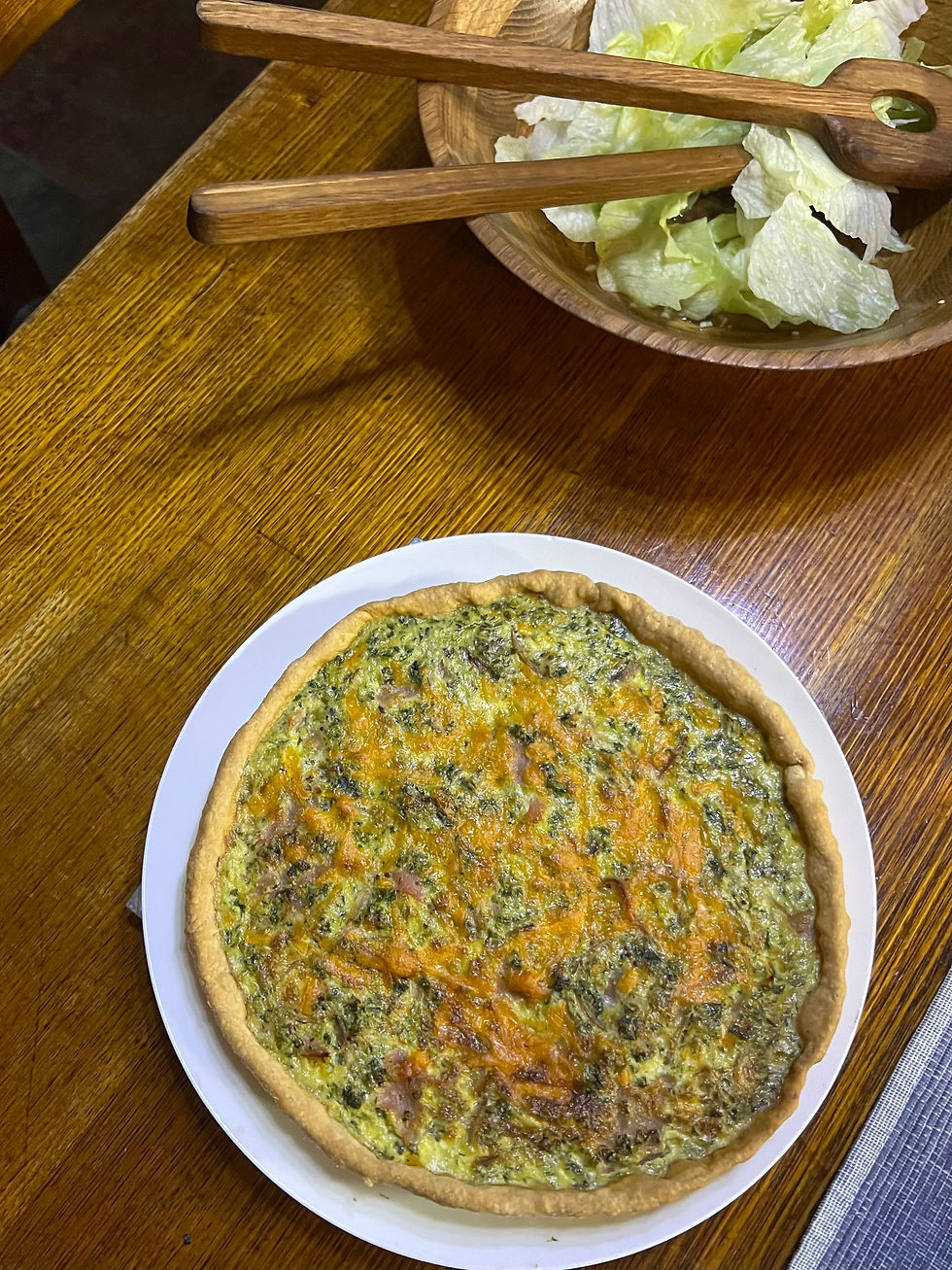
Thomas Keller also trimmed the top of his quiche after it is cooked. Now I learnt - also from where I do not know - to roll out the pastry larger than required to line the tin, and then I go round folding over the overhang, trying to make the size taller than the tin, as it does indeed shrink in the cooking. Folding it over gives it a smoother finish on the top, as shown here. So that's lesson number five. The folded over pastry is uneven of course against the sides of the tin, but that doesn't matter as the filling covers it.
Lesson number six - a very quick one. Make sure you have no holes in the pastry. Even a small crack will mean your filling will seep through and the quiche will stick to the tin.
Lesson number seven - prebake your pastry shell. I have a feeling that years ago I did not do this, although maybe that was pies, not tarts. I certainly didn't do it for long enough back in the day. Today I cook it for nine minutes with a pricked base, a lining of greaseproof paper and pastry beans or whatever you use. I used to use dried beans until I found some ceramic ones in Aldi. Then I take it from the oven, remove the paper and beans and bake it for a further 9 minutes. Oven setting - 180°C on my oven's Pizza setting which is fan forced with heat from the bottom of the oven. That longer cooking of the pastry certainly improved my pastry shell enormously.
Back to that filling which is basically a custard with things.
“Quiche really can be whatever you want it to be, so don’t worry about following exact rules. That said, a rough formula is always helpful. It’s some sort of creamy thing [creme fraiche, cream cheese, ricotta, say], plus an egg or two [depending on the size of the quiche/tart you’re making], plus any ingredients you have in your fridge.” Kitty Coles/The Guardian
I do occasionally stray from that 3 eggs 300ml formula and use crème fraïche, or ricotta. Mostly however it's ordinary old cream. Which I beat with a fork until it's a tiny bit frothy and all the yolk has disappeared and the colour is uniform. Doesn't take long. To this I add any herbs or flavourings such as mustard or spice. Is that a lesson? Not really I think.
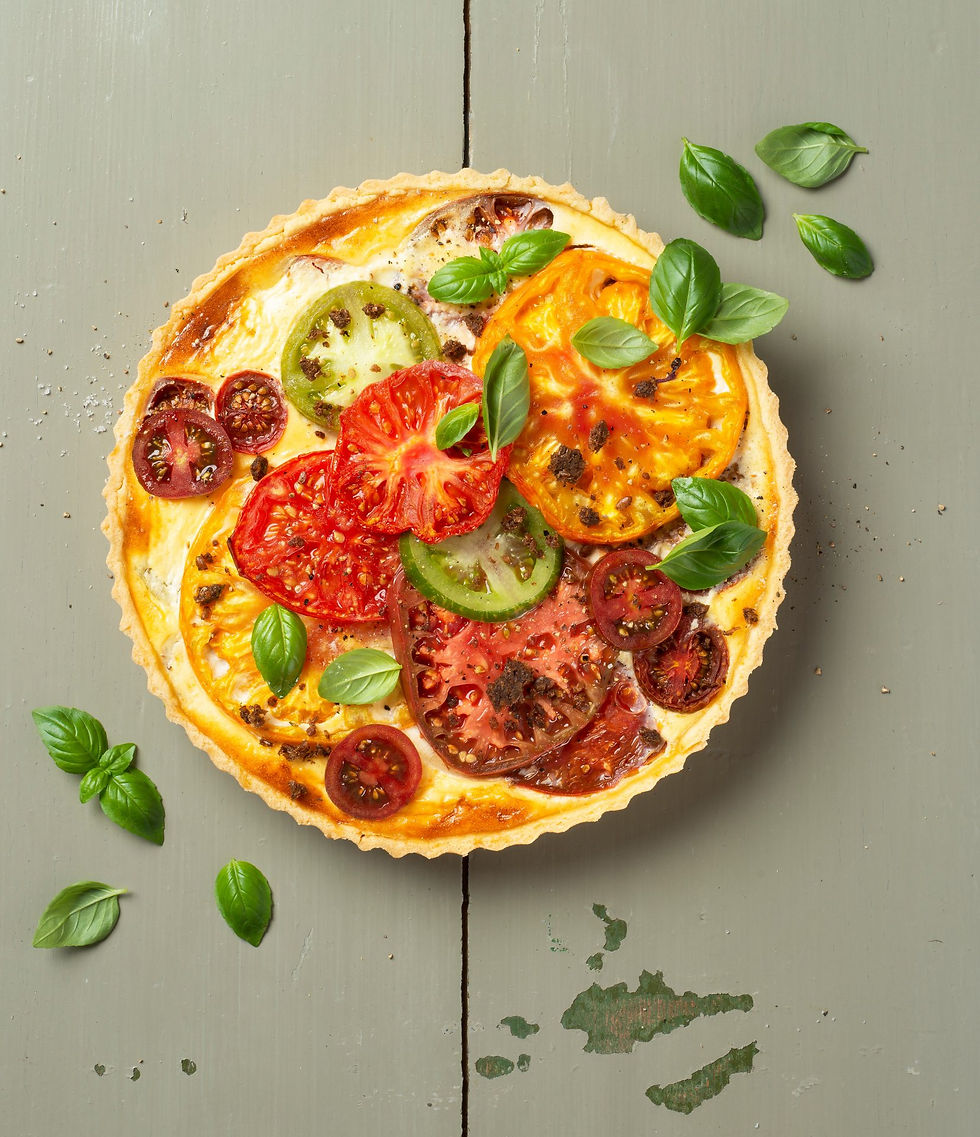
The filling however has just a couple of rules - well things I have learnt over the years. Lesson number eight - make sure your filling is dry - well sort of. What I mean is that you don't want a lot of juice, so it's best to cook your ingredients first - I generally do that in the microwave - just to soften them, and then drain them. Tomatoes are a bit of a disaster as they exude so much juice in the cooking. People get around this mostly by slicing them, possibly draining them for a while, and then just perching them on top - as here. Or they roast them and drain them, or they use sun-dried tomatoes. It's tricky. Or you can make a very thick tomato sauce and mix it with your custard mixture.
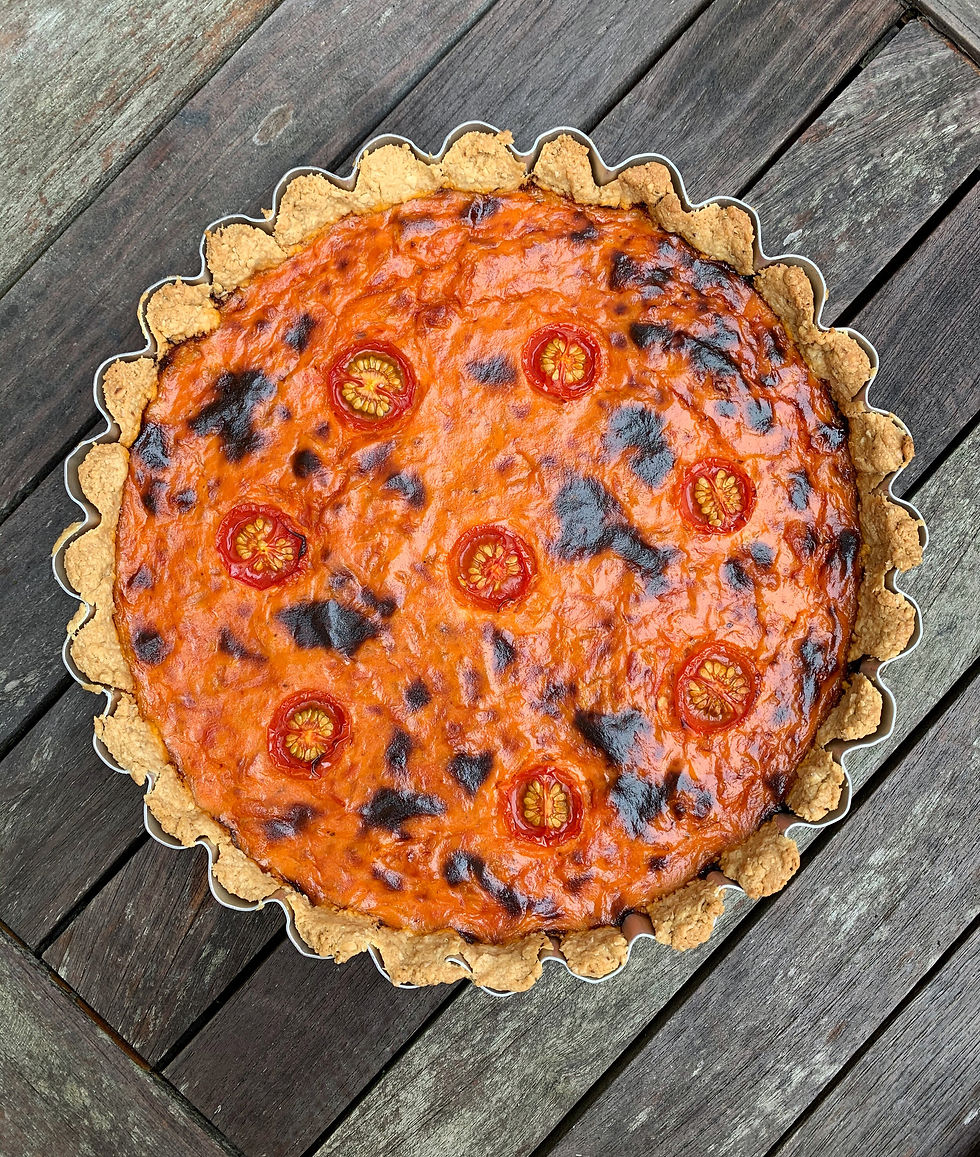
Jane Grigson has a recipe - and this one is definitely worth a look and a try - Roast tomato and harissa tart - the recipe is on the website The Zest. Mind you I don't know why the author calls it Roast tomato, because basically you cook down a tin of tomatoes to a very thick purée. It uses that oat based pastry, so probably hardly qualifies as a quiche at all.
But then the filling is indeed the interesting and satisfying part. Satisfying in that you can rid your fridge of leftovers, and also that you can experiment with flavours - what goes with what - the recreation that Nigel Slater talks about in his article. It's a marvellous way to use up some of those jars of condiments and the slightly wilting vegetables, the deteriorating ham and bacon ... There's probably a fine line between experimentation and disaster however.
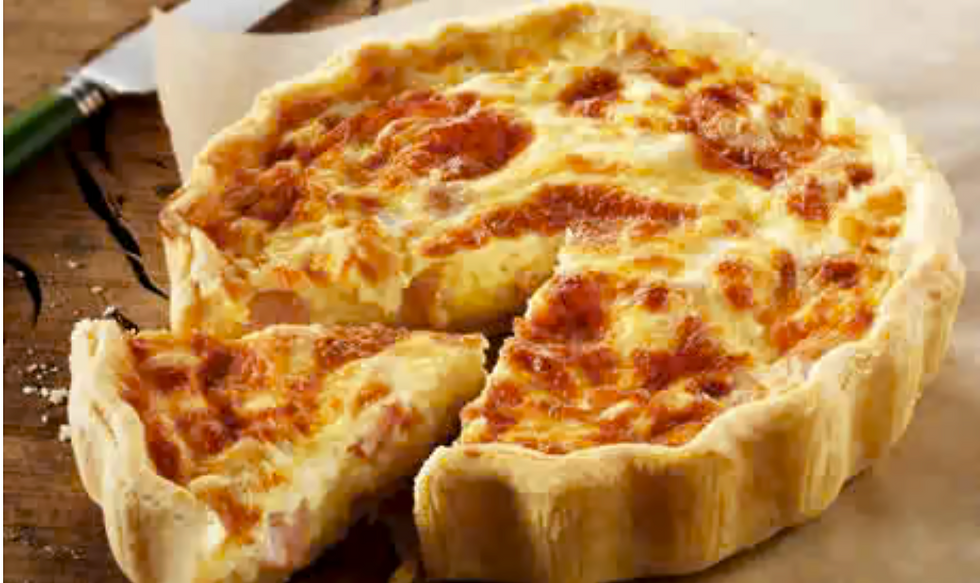
Felicity Cloake, in her article about making the perfect Quiche Lorraine, (the result is shown here) ays she once tasted one "studded with meatballs, the memory of which still keeps me awake". The Guardian also had an article in which they had asked readers for their favourites, one of whom:
"Lisa Ingram, who describes herself as a “Galactic Federation Adviser”, tests our incredulity by recommending a quiche filled with old spaghetti. “Mix a few eggs with your tomato spag leftovers, season with Italian herbs, throw into a pastry shell and top with cheese,” she writes. “Feels so wrong, tastes so right.” I’m going to take her word for it." The Guardian
Lesson number nine - Mix your filling ingredients with the custard mix. Many recipes tell you to put the filling on the pastry shell and then pour the custard on top, but I think if you mix them all together you get a rather tastier finish - everything blended together - and if your custard is not super smooth and silky it doesn't matter.
Last lesson - number 10 - grate some cheese on top. I rarely do not do this. Maybe if it's very fishy - smoked trout, salmon, and so on. But it sure is the final touch.
"Nothing tempts like a tart. The buttery crust crumbles under your fork, the savoury filling quivers. You lift it slowly, carefully, from plate to mouth so as not to lose even the tiniest bit down your shirt. The pastry melts in your mouth, the filling dissolves on your tongue. A crumb falls, a crumb that you will rescue later with a licked finger. No roast, no cake, no fruit can tempt and please the way a slice of warm, home-baked tart does." Nigel Slater
I do try not to just quote Nigel, but he always says things so beautifully.
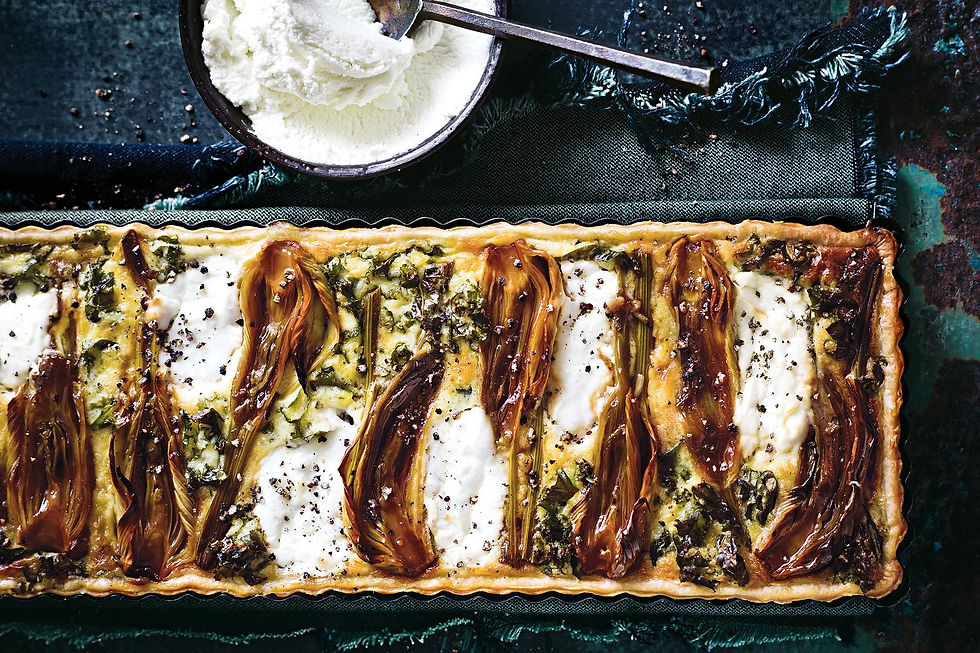
And there is no rule about a quiche having to be round either - this one is caramelised fennel, kale and goat's curd. You can jut put things on top if it's decorative. Asparagus is good on top too.
POSTSCRIPT
Those years gone by. august 14
2023 - Watermelnon, feta, mint
2022 - There's a big gap here in 2022
2021 - Nutella
2019 - Varieties of lemon tart
2018 - A mouli in my cooking life
2016 - Cauliflower cheese
Comments